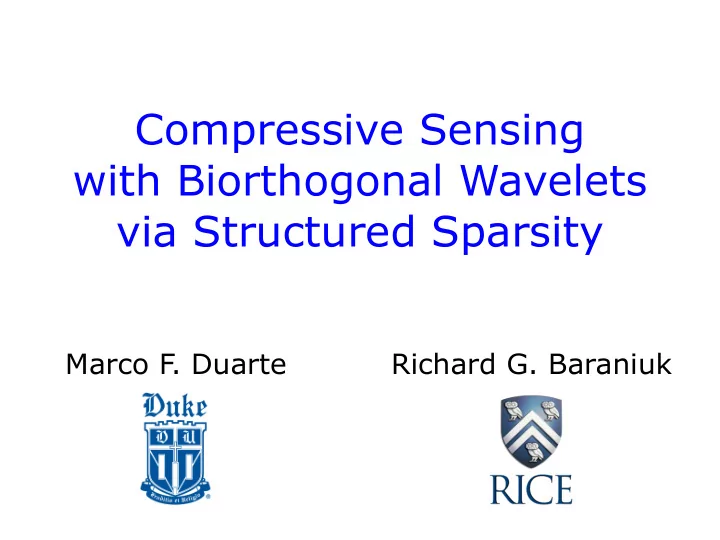

Compressive Sensing with Biorthogonal Wavelets via Structured Sparsity Marco F. Duarte Richard G. Baraniuk
Compressive Imaging • Data x K -sparse in orthonormal basis : • Measure linear projections onto incoherent basis where data is not sparse x project transmit receive recovery • Reconstruct via optimization or greedy algorithms (CoSaMP, OMP, IHT, ...)
Restricted Isometry Property (RIP) • Preserve distances between sparse/compressible signals [Candès and Tao 2005] • RIP of order 2 K implies: for all K -sparse and RIP of order 2 K enables K -sparse signal recovery • Random matrices lead to RIP with high probability if Φ when is an orthonormal basis • i.i.d. Subgaussian entries: Gaussian, Rademacher, ...
Example: Compressive Imaging • Example: Recovery via CoSaMP using 2-D Daubechies-8 wavelet Original SNR = 17.93dB N = 262144, M = 60000 • 2-D wavelets and 2-D DCT are common
State-of-the-Art Image Compression • JPEG 2000 • Lossy compression via transform coding • Cohen-Daubechies-Feauveau 9/7 Biorthogonal Wavelet (CDF 9/7)
Properties of Biorthogonal Wavelets • Biorthogonal wavelets involve: – an analysis basis – a synthesis basis • Transform coding: • Analysis and synthesis bases are not orthonormal : • Standard guarantees and algorithms are not necessarily suitable for biorthogonal wavelets
Beyond Orthonormal Bases • Dictionary : arbitrary matrix (basis/frame) that provides sparsity • Dictionary coherence • Theorem : [Rauhut, Schnass, Vandergheynst 2008] If has rows and then the matrix has RIP of order K • Sadly, CDF 9/7 synthesis basis has large coherence:
CS with Coherent Dictionaries • For tight frame dictionaries with arbitrary coherence, can use - analysis : -norm minimization for analysis coefficients • New - RIP preserves distances between signal vectors instead of coefficient vectors • -RIP is tailored to dictionary and enables guarantees for recovery via -analysis (in contrast to -synthesis) • Random matrix has -RIP if [Candès, Eldar, Needell, Randall 2010]
Compressive Imaging via Biorthogonal Wavelets • Example: Recovery via CoSaMP using CDF 9/7 wavelet Original SNR = 4.6dB N = 262144, M = 60000
Compressive Imaging via Biorthogonal Wavelets • Example: Recovery via -synthesis using CDF 9/7 wavelet Original SNR = 21.54dB! N = 262144, M = 60000
Benefits of Biorthogonal Wavelets • Why does -synthesis work well? • Because biorthogonal wavelet analysis and synthesis bases are “ interchangeable ”: • Thus, we have and the following two formulations are equivalent : ( -synthesis) ( -analysis)
CDF 9/7 Recovery Artifacts “Ringing”
Coherence of Biorthogonal Wavelets • Each wavelet is coherent with spatial neighbors across different wavelet orientations and scales • Ringing artifacts caused by ambiguity due to coherent/neighbor wavelets during sparse wavelet selection • Can inhibit supports that include coherent pairs of neighboring wavelets
Structured Sparsity Models • Promote structure common in natural images • Inhibit selection of additional highly-coherent wavelet pairs
Structured Sparse Recovery Algorithms • Modify existing greedy algorithms that rely on thresholding (e.g. CoSaMP) • Replace thresholding with best structured sparse approximation that finds the closest point to input x in a restricted union of subspaces that encodes structure: R N x [Baraniuk, Cevher, Duarte, Hegde 2010] Ω K
Connected Rooted Subtree Sparsity • Structure: K -sparse coefficients + nonzero coefficients lie on a rooted subtree • Approximation algorithm: – condensing sort and select [Baraniuk] – dynamic programming [Donoho] – computational complexity: • Measurements needed: for random matrices with i.i.d entries, without structure with structure
CS via Biorthogonal Wavelets • Example: Recovery via tree-CoSaMP using CDF 9/7 wavelet Original SNR = 23.31dB N = 262144, M = 60000
Original CoSaMP CoSaMP Daubechies-8 CDF 9/7 N = 262144 SNR = 17.93dB SNR = 4.60dB -analysis Tree-CoSaMP Tree-CoSaMP CDF 9/7 Daubechies-8 CDF 9/7 SNR = 21.54dB SNR = 22.14dB SNR = 23.31dB
Performance Comparison - Cameraman -analysis/CDF97 N = 262144
Conclusions • Structured sparsity enables improved greedy algorithms for compressive imaging with 2-D biorthogonal wavelets – promote structure present in wavelet representations of natural images – inhibit interference from neighboring wavelets that do not match model – simple-to-implement modifications to recovery that are computationally efficient – reduced number of random measurements required for improved image recovery • Current and future work: – analytical study of 2-D biorthogonal wavelets (coherence, RIP) for compressive imaging – Extensions to redundant wavelet frames cs.duke.edu/~mduarte dsp.rice.edu/~richb dsp.rice.edu/cs
Recommend
More recommend